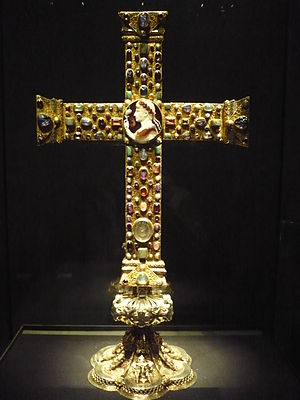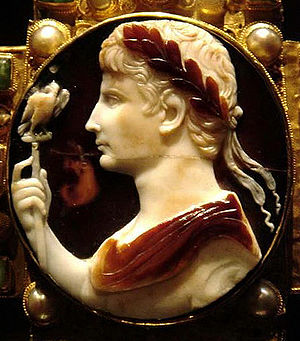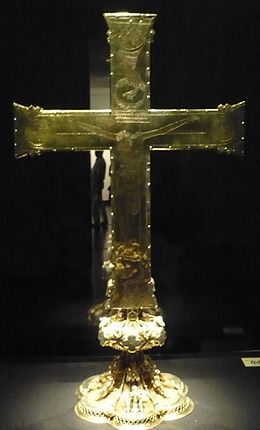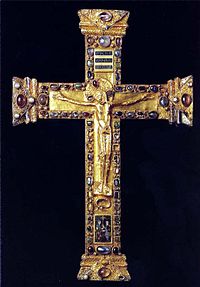- Cross of Lothair
-
The Cross of Lothair or Lothair Cross (German: Lotharkreuz) is a crux gemmata (jewelled cross) processional cross dating from about 1000 AD, though its base dates from the 14th century. It was made in Germany, probably at Cologne.[1] It is an outstanding example of medieval goldsmith's work, and "an important monument of imperial ideology",[2] forming part of the Aachen cathedral treasury, which includes several other masterpieces of sacral Ottonian art. The measurements of the original portion are: height: 50 cm, width: 38.5 cm, depth: 2.3 cm. The cross comes from the period when Ottonian art was evolving into Romanesque art, and the engraved Crucifixion on the reverse looks forward to the later period.
Contents
History
The Cross takes its name from the large engraved greenish rock crystal seal near its base bearing the portrait and name of the Carolingian ruler Lothair II, King of Lotharingia (835–869), and a nephew of Charles the Bald. It was actually made over a century after Lothair’s death for one of the Ottonian dynasty, the successors of the Carolingian dynasty; possibly for Otto III, Holy Roman Emperor.[3] It appears to have been donated to the Cathedral as soon as it was made.
The Cross is still used in processions today. On high feast days it is carried into Aachen Cathedral where it is placed next to the main altar during mass. For the rest of the time it is on display in the Cathedral Treasury Museum.
Description and interpretation
The oak core of the Lothair Cross is encased in gold and silver and encrusted with jewels and engraved gems - a total of 102 gems and 35 pearls. The front of the cross (in the terms used here) is made of gold and silver plate and is richly decorated with precious stones, pearls, gold filigree and cloisonné enamel.[4] There is a case for describing this as the reverse side, as some sources do, as it may have been carried that way in processions, with the plain engraved crucifixion facing forward, and the gem-encrusted face facing the emperor who followed the cross. The enamel is on the bands of the terminals that are interrupted by the points of the triangular sections. The gems in the centre rows are mounted in raised drum-like platforms, their sides decorated with arcades in filigree. The flat surface of the arms is decorated all over with filigree tendrils.[5] At the meeting point of the arms is a first century AD sardonyx three-layered cameo of the Roman Emperor Augustus holding an eagle sceptre,[6] also mounted on a raised drum.[7]
On the assumption that the Ottonians were aware that the cameo was a portrait of Augustus, it served to link the Ottonian dynasty with the original Roman emperors, and assert them as God's representatives on earth.[8] On the other hand, an engraved gem portrait of Augustus's daughter Julia at the top of the "Escrin of Charlemagne", an elaborate treasure given to the Abbey of Saint-Denis by Charles the Bald, was treated as an image of the Virgin Mary. Another gem portrait of the Roman Emperor Caracalla had a cross and the name of Saint Peter added to it before use in metalwork for the Sainte-Chapelle in Paris. It is now impossible to know the degrees of awareness of this iconographic recycling among the different categories of people creating and seeing these objects.[9]
The second largest gem, below Augustus, was probably Lothair's seal and has his portrait with the inscription "+XPE ADIVVA HLOTARIVM REG" ("God save King Lothar").[10] This served a similar function, linking the Ottonians with the Carolingian dynasty who had established the position of Holy Roman Emperor. Other gems on the cross have classical carvings on them, including an amethyst with the Three Graces and a lion in onyx, both of which are mounted with the images placed sideways.[11]
The reverse side of the Cross is a plain gold plate engraved with the “Crucifixion of Jesus”, with above it the Hand of God holding a victor's wreath containing the dove of the Holy Ghost; here this represents God the Father's acceptance of Christ's sacrifice. This is the earliest known appearance of the dove in this motif, which introduces the whole Trinity into a crucifixion, an iconography that was to have a long future.[12] The Serpent, representing Satan, is twined round the bottom of the cross. In medallions at the ends of the arms are personifications of the sun and moon with heads bowed and surmounted by their symbols.[13] The Hand with the wreath was a common motif in mosaics in Rome, and also used in art associated with the early Holy Roman Emperors, including in illuminated manuscript portraits of themselves, to emphasize their authority from God.
This is an outstanding and moving example of the “Crucifixion”, closely related to the slightly earlier life-size wooden Gero Cross in Cologne, which was a crucial work in developing the Western image of the dead crucified Christ, whose head is slumped to his shoulder, and whose sagging body forms a S shape, showing the marks of his suffering, here with blood spurting from the spear-wound in his side.[14] Engraved backs are found in many jewelled crosses of the period.[15] The cross is now mounted on a 14th century Gothic stand, itself decorated with two small crucifixions and other figures.
This style of gem-studded gold decoration, re-using material from antiquity, was usual for the richest objects at the time.[16] In particular, the motif of the glorified jewelled cross, a "transformation of the crude gibbet on which Christ died", goes back to Late Antiquity, when pagan opponents of Christianity often mocked the mean nature of the primary Christian symbol.[17] Until about the 6th century, crosses rarely showed the figure of Christ, but by 1000 other grand jewelled crosses had already moved the crucifixion, usually in gilded cast bronze, to the front face of the cross, to make them crucifixes, which would remain the most common Catholic form of cross. Some examples are the crosses of Bernward of Hildesheim (c. 1000, Hildesheim Cathedral), Gisela of Hungary (Regensberg, 1006, now Munich Residenz[18]), and Mathilda of Essen (973, Essen Cathedral, see left),[19] which uses a virtually identical design for the terminals of the arms to the Lothair Cross.[20]
The Lothair Cross is in this respect a somewhat conservative object, leaving the front free for imperial symbolism, and also perhaps as a deliberate revival of Carolingian style; for example most rich crosses of similar date made more use of enamel. The two sides can be taken to represent Church and state, fittingly for an Imperial donation that was carried in front of the Holy Roman Emperors as they processed into the church.[21] The broad form of the design matches that of the small cross at the front of the Imperial Crown of the Holy Roman Empire (c. 973/83?), which also has a jewelled front side and an engraved crucifixion on the rear.[22]
Notes
- ^ Calkins, p. 115; agreement on the approximate date is unanimous among the works cited, except for Lasko p. 101, who sees no need to date it later than the 980s, and also describes it as an "altar cross".
- ^ Barasch, p. 30
- ^ Calkins, 115, and most scholars except Lasko 101, who sees no need to date it later than the 980s.
- ^ Henderson, p. 261, n. 135.
- ^ See the close-up photo in external links
- ^ Calkins, 115
- ^ Close-up photo
- ^ Calkins, p. 115. He makes this assumption.
- ^ Henderson, pp. 110-111 for the "Escrin", or Lasko 24-6 and figs. 23 & 24 for the 1790s drawing - he uses "Escrain". The Julia gem is here, and the Caracalla gem is here. Both now survive in the BnF detached from their original settings, which were destroyed during the French Revolution.
- ^ Lasko, 49 points out that the inscription is not reversed, and so would not have read correctly on a wax impression, making it unlikely it was actually used as a seal
- ^ The Three Graces are the central purple gem two down from Augustus, and the lion is black, on the left of the top section of the main shaft. See the close-ups in the external links section.
- ^ Schiller, pp. 108, 122
- ^ Swartzenski, p. 42 and figs. The clearest photo illustration is in Schiller, II, fig. 395, and Lasko, p. 100 has a drawing.
- ^ Schiller, p. 142. See also Richard Herries here
- ^ See for example those illustrated in Legner, III, H28, H29 and H31
- ^ Calkins, 115, Lasko 99-106 and passim
- ^ Henderson, 202-209, quotation, p. 208
- ^ Commons photo of Cross of Gisela of Hungary and German Wikipedia article
- ^ All covered and illustrated in Lasko, or see Beckwith, pp. 138-143, and Swartzenski, p. 42 and figs.
- ^ Lasko, 100
- ^ Honour and Fleming, 273
- ^ Both sides illustrated in Lasko, plates 81 and 82
References
- Barasch, Moshe, The language of art: studies in interpretation, NYU Press, 1997, ISBN 0-8147-1255-X, 9780814712559, Google books (See also here)
- Beckwith, John. Early Medieval Art: Carolingian, Ottonian, Romanesque, Thames & Hudson, 1964 (rev. 1969), ISBN 0-500-20019-X
- Calkins, Robert G.; Monuments of Medieval Art, Dutton, 1979, ISBN 0-525-47561-3 Google books
- Henderson, George. Early Medieval Art, 1972, rev. 1977, Penguin.
- Hugh Honour and John Fleming, A World History of Art,1st edn. 1982 & later editions, Macmillan, London, page refs to 1984 Macmillan 1st edn. paperback. ISBN 0-333-37185-2
- Lasko, Peter, Ars Sacra, 800-1200, Penguin History of Art (now Yale), 1972 (nb, 1st edn.) ISBN14056036X
- Legner, Anton (ed). Ornamenta Ecclesiae, Kunst und Künstler der Romanik. Catalogue of an exhibition in the Schnütgen Museum, Köln, 1985. 3 vols.
- Schiller, Gertrud, Iconography of Christian Art, Vol. II, 1972 (English trans from German), Lund Humphries, London, ISBN 853313245
- Swarzenski, Hanns. Monuments of Romanesque Art; The Art of Church Treasures in North-Western Europe, Faber and Faber, 1974, ISBN 0-571-10588-2
External links
Photos:
- Close-up side view of jewels and filigree work - Aachen Cathedral website
- Good zoomable view of the front - Aachen Cathedral website
- Central part of the back side
- Lothair's seal gem
- Three Graces, from good flickr set of close-ups
Form of cross typical of Early Christian and Early Medieval art, where the cross, or at least its front side, is principally decorated with jewels. VIth- IXth century Cross of Justin II • Cross of the Angels • Cross of Agilulf • Cross of Duke Gisulf • Cross of the King Desiderius • Treasure of Guarrazar • Ardennes CrossXth century Victory Cross • Cross of Lothair • Cross of Mathilda and Otto • Cross of PeñalbaXIth century Cross of San Salvador de Fuentes • Cross of Stift EngerXIIth century Cross of Cong • Cross of Adelheid • Cross of ChersonesusCategories:- Medieval European sculptures
- Sacramentals
- Aachen
- Gold objects
- Hardstone carving
- Romanesque art
- Roman Empire cameos
- Crux gemmata
Wikimedia Foundation. 2010.




